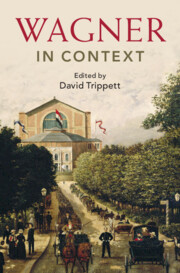Book contents
- Wagner in Context
- Composers in Context
- Wagner in Context
- Copyright page
- Contents
- Illustrations
- Musical Examples
- Contributors
- Acknowledgements
- Abbreviations
- Introduction
- I Place
- II People
- III Politics, Ideas, and Bodies
- IV Life, Language, and the Ancient World
- V Music and Performance
- Chapter 29 Orchestration
- Chapter 30 Wagner and Analysis: Siegfried and the Rheinmaidens
- Chapter 31 The Scene of Grand Opera
- Chapter 32 Wagner on the Move
- Chapter 33 Stage Technology
- Chapter 34 Historic Stagings: 1876–1976
- VI Reception
- Further Reading
- Select Bibliography
- Index
Chapter 30 - Wagner and Analysis: Siegfried and the Rheinmaidens
from V - Music and Performance
Published online by Cambridge University Press: 14 March 2024
- Wagner in Context
- Composers in Context
- Wagner in Context
- Copyright page
- Contents
- Illustrations
- Musical Examples
- Contributors
- Acknowledgements
- Abbreviations
- Introduction
- I Place
- II People
- III Politics, Ideas, and Bodies
- IV Life, Language, and the Ancient World
- V Music and Performance
- Chapter 29 Orchestration
- Chapter 30 Wagner and Analysis: Siegfried and the Rheinmaidens
- Chapter 31 The Scene of Grand Opera
- Chapter 32 Wagner on the Move
- Chapter 33 Stage Technology
- Chapter 34 Historic Stagings: 1876–1976
- VI Reception
- Further Reading
- Select Bibliography
- Index
Summary
The chapter offers a focused historical account of Anglophone analysis of Wagner’s music, particularly that of the Ring, beginning with the work of the British Wagnerians Ernest Newman and Deryck Cooke, and continuing to that of more recent American scholars such as Robert Bailey and Warren Darcy. The central task of the chapter is to trace the analytical approaches of these and other scholars to three critical elements of Wagner’s music: leitmotiv, tonality and harmony, and form. The scene between Siegfried and the Rhinemaidens in Act 3, Scene I of Götterdämmerung serves as an example of how these analytical approaches can work, either separately or together, to enrich our understanding of Wagner’s musical practice in his penultimate opera.
Keywords
- Type
- Chapter
- Information
- Wagner in Context , pp. 300 - 310Publisher: Cambridge University PressPrint publication year: 2024

